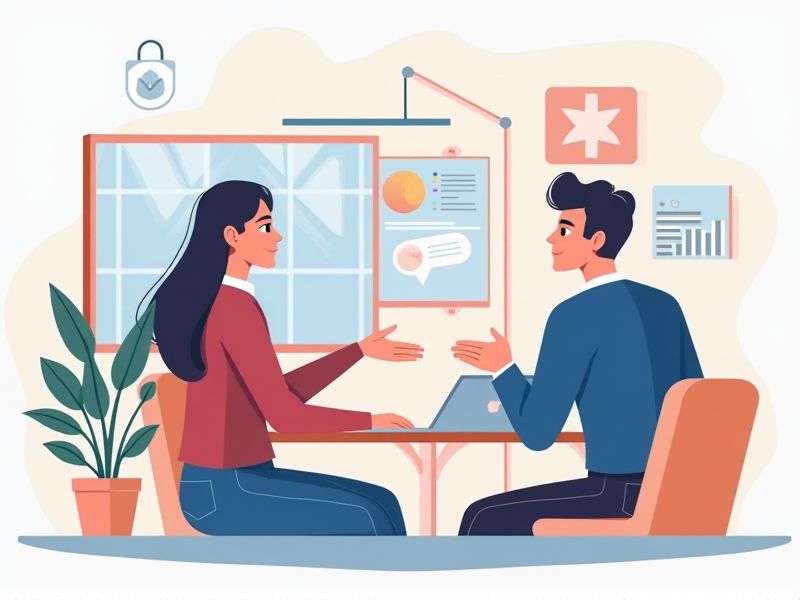
To improve communication, it's crucial to understand that everyone perceives the world differently, as noted by Tony Robbins: "To effectively communicate, we must realize that we are all different in the way we perceive the world and use this understanding as a guide to our communication with others". This awareness helps tailor messages to specific audiences, ensuring clarity and effectiveness. Effective communication also involves active listening, as emphasized by Ernest Hemingway: "When people talk, listen completely. Most people never listen". By combining these strategies, individuals can enhance their communication skills and foster stronger connections with others.
How to Be Better at Communicating
Active Listening
Active listening involves focusing fully on the speaker, processing their message without distractions, and resisting the urge to formulate a response until the other person has finished. This heightened focus reduces misunderstandings by ensuring that you accurately interpret both the facts and feelings conveyed in the conversation. By summarizing or asking clarifying questions, you establish a feedback loop that reinforces shared understanding and builds trust. Consistently practicing these active listening techniques can transform your communication, leading to more productive interactions and stronger relationships.
Clear Articulation
Clear articulation begins with the mindful selection of words and deliberate pace of speech. It enhances listener comprehension, reducing ambiguity and the likelihood of misunderstandings. Regular practice, such as reciting presentations or engaging in conversational exercises, can improve the precision of delivered ideas. This focused improvement in speech clarity leads to deeper, more impactful connections during both personal and professional interactions.
Empathy
Empathy enhances communication by allowing you to actively listen and understand the emotions behind words. This approach fosters trust and creates space for honest dialogue that can address underlying concerns. Studies show that teams with high empathetic communication reduce conflicts and boost collaboration by up to 30%. Integrating empathy into everyday conversations helps transform misunderstandings into opportunities for connection and growth.
Nonverbal Cues
Observing body language and facial expressions delivers cues that profoundly affect interpersonal interactions. Making consistent eye contact naturally builds trust and establishes clarity in conversations. Adjusting your posture and gestures can reinforce your message and enhance perceived credibility. Monitoring nonverbal signals, such as tone and pace of speech, directly contributes to improved communication outcomes.
Audience Awareness
Understanding your audience enhances the relevancy and clarity of your message by tailoring language, examples, and complexity to meet their expectations. Analyzing demographic, cultural, and experiential data allows you to craft content that resonates directly with listener needs and interests. Matching delivery style--whether formal, informal, technical, or broadly accessible--to the audience's familiarity with the topic increases overall engagement. Soliciting and incorporating targeted feedback creates a dynamic loop that refines communication strategies based on quantifiable listener responses.
Concise Messaging
Focus on identifying your core message before you start writing or speaking, as clarity in purpose minimizes the risk of going off-topic. Trim unnecessary words and repetitive phrases to ensure every part of your message adds value; data shows that concise communication increases retention by up to 40%. Structure information logically and prioritize important details, which helps your audience process the message efficiently. Practice regularly by recording and reviewing your communications to identify habits that cloud the core message and make adjustments based on audience feedback.
Open-Ended Questions
Open-ended questions prompt detailed responses by encouraging individuals to elaborate on their thoughts and experiences. They drive the conversation deeper, unearthing insights that simple yes/no answers might obscure. This approach facilitates a clearer understanding of perspectives, fostering a sense of engagement and trust. Regular use of such questions enhances both personal and professional interactions by uncovering underlying motivations and promoting meaningful dialogue.
Feedback Integration
Developing effective communication relies on a feedback integration process that continuously refines message clarity and audience engagement. Actively seeking and analyzing peer or mentor feedback can uncover hidden biases and unlock new perspectives. Systematically applying insights from constructive criticism has been linked to measurable improvements in message delivery and comprehension. Embracing a feedback-driven approach enables communicators to adapt dynamically, ultimately fostering richer and more productive dialogues.
Adaptability
Adaptability in communication involves tuning your message style to suit diverse audiences and situations, ensuring that your intended meaning is clearly conveyed. Flexibility in approach allows you to respond promptly to feedback and adjust your delivery in real time, which enhances understanding. Embracing different perspectives and modifying your language based on context can bridge potential gaps, leading to more efficient and effective interactions. By continuously monitoring and evaluating the impact of your communication, you can refine your techniques to foster stronger connections and improved outcomes.
Confidence
Developing confidence through consistent practice enhances communication by reducing anxiety when presenting ideas. Engaging in structured public speaking or group discussions builds self-assurance that directly improves clarity and persuasive power. Adopting assertive body language and maintaining meaningful eye contact signals self-reliance, which research shows increases listener trust and engagement. Investing in thorough preparation and continuous feedback cultivates mental resilience, thereby transforming effective communication into a natural, confident skill.
Summary
Active Listening sharpens your understanding of speakers by ensuring you capture key points and underlying emotions. Clear Articulation then allows you to express your own thoughts in a structured and accessible way, minimizing the risk of misinterpretation. Empathy bridges these strategies by fostering a connection that values the listener's perspective, which is essential for genuine dialogue. Together, these techniques build a robust framework for communication that is both effective and mutually respectful.
